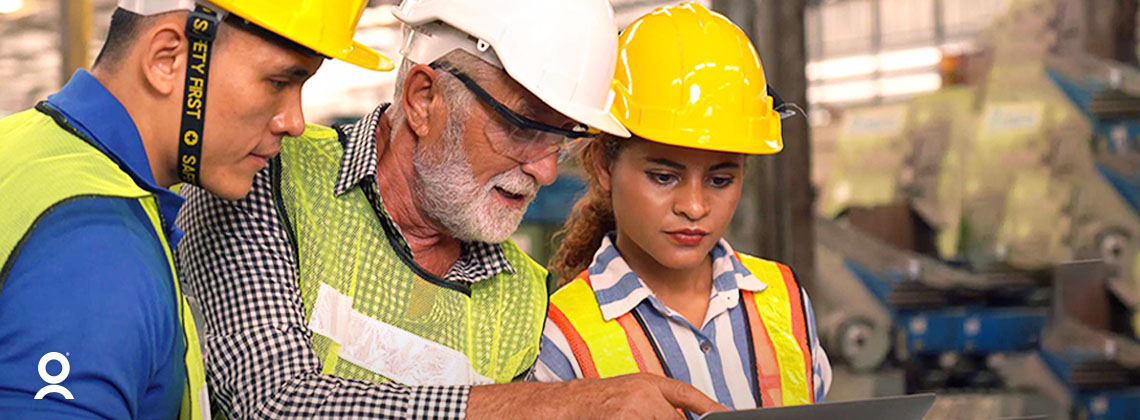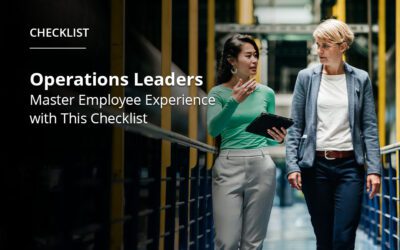7 Ways to Improve Employee Experience in 2022

Your employees expect a productive, engaging, and dynamic work environment due to the increasingly transparent digital workplace and the growing influence of millennials. Organizations are rapidly shifting away from the narrow focus of just employee engagement and culture, and instead, are considering the entire employee experience – workplace, HR, and management practices – that affect people on the job.
Engaged employees are beneficial to a company, but disengaged ones can be a heavy cost. A recent Gallup report determined that a company with 10k employees earning an average 50k each, the accumulated cost of disengagement would be $60.3 million annually. Companies are taking note by investing in a range of programs aimed at enhancing the overall employee experience.
The main question is: What makes work experiences positive and motivating? Ultimately, it’s about the growth, meaning, and purpose people find in their work. To address these issues, the entire organization must be involved. Importantly, research shows that the work itself is what matters most: making work meaningful and giving people a sense of belonging, trust, and ownership. Rather than viewing work experiences through a lens of perks and rewards, companies should focus on factors like job fit, job design, and meaning for ALL their employees.
With this in mind, employee experience management should be a key managerial, operational, and human resources concern for all organizations that want to stay competitive in an extremely challenging business climate.
Here are seven ways to significantly improve employee experiences in 2022.
1. Optimize Each Stage of the Employee Life Cycle (ELC)
The employee life cycle (ELC) is a useful framework for analyzing the different stages workers go through from hiring to off-boarding. The employee journey shapes their entire company experience.
The main stages of ELC include the following:
- Recruitment and Hiring
- Onboarding and Orientation
- Training and Development
- Retention and Employee Satisfaction
- Offboarding and Exit Interviews
Recruitment and selection are a prospect’s first point of contact with a potential employer. These first impressions can mold the long-term perception workers will have for an organization.
The hiring and onboarding phase marks the official change of their status from candidate to employee. A company’s orientation program and onboarding experience are crucial to employee success, and yet, many organizations lack forethought for both areas.
Thus, programs should be measurable, targeted to specific audiences, and have clear objectives. For example, deskless shift workers are trained very differently than remote customer service representatives, and yet many companies will train them with the same methods as office workers, regardless of whether this information fits their roles. Employers should take these differences into account and provide programs and tools catered to specific employee types.
When employees know there is room for career advancement, they are more likely to stay at a company longer. With an effective training and development program in place, organizations can focus on developing the next generation of leaders in-house. In turn, employees will be more likely to remain motivated and loyal, safe in the knowledge that their company is investing in them and their future.
However, no business wants to develop its workers only to experience attrition due to a competitor. Organizations can retain top talent by providing the necessary incentives to keep them motivated. Part of training and development is allowing employees to recalibrate their goals. It also creates a benchmark to assess workers’ performance.
As useful as they are for data purposes, exit interviews do not help much when an employee has already made the decision to quit. Rather, stay interviews are open conversations between employer and employee designed to draw out what workers value and want (and don’t want). Employers who engage in stay interviews with current employees can gain a better understanding of what motivates their teams and can take action to maximize retention. This way, managers can gain valuable insight into what drives them so they can develop strategies to keep employees engaged, and ultimately, retain them within the organization.
2. Enrich Internal Communication to Improve Employee Experience
Communication is an essential tool to nurture a positive employee experience. Clear communication not only helps workers and management exchange information fast, but it further builds trust and connections while improving collaboration and raising engagement levels.

Communication teams are responsible for more than just disseminating information, though. They create a sense of community, motivate employees to work together toward a common goal, and build a cohesive company culture. With a greater sense of purpose, employees automatically become more productive, more engaged, and more loyal. They’re also more likely to become brand ambassadors for a company.
Leaders know that consistent performance requires an informed and engaged workforce. Simplified communications that are easy to use and accessible to everyone streamline the process and can revolutionize employees’ experiences.
WorkForce Software’s dynamic communication solution provides a secure place to reach and engage employees, just like accessing their favorite app. It enables real-time communication and two-way conversations with direct messaging. Sharing important announcements and keeping everyone in the loop is a snap. Create positive employee experiences by providing deskless shift workers easy access to their employee information, schedules, pay sheets, time tracking, and attendance logs all in one accessible online app.
3. Prioritize Employee Wellness
Let’s look at some compelling statistics that highlight the importance of flexibility at the workplace:
- While 83% of employers believe they offer work flexibility, only 60% of employees agree
- 83% of employers believe they adjusted schedules accordingly due to Covid-19. Only 69% of workers agree
Flexibility, no doubt, is a critical part of workers’ well-being. The last thing an employee wants is a stressful job that doesn’t yield any free time. Workers with unhealthy work-life balance tend to be less motivated. As such, employers should keep tabs on all the varied aspects of employee wellness to ensure they have positive experiences.
Flexible work schedules are positively associated with employee well-being through enhanced work/life balance, autonomy, and effective communication. Common work flexibility types include remote working, paid time-offs/leaves, and schedule shifting/swapping. Allowing employees to optimize their own schedules enables them to allocate time and resources for both work and non-work domains based on their needs and preferences. For instance, employees would have more capacity to address personal and family needs, including childcare, eldercare, schooling, and healthcare.
In the present global health situation, fatigue, burnout, and health risks (not only for the employee, but for their families as well), can be addressed by company policies allowing for flexible schedules and work setup.
There is often a gap between what employees want and what their employees need. Unfortunately, it can take multiple resignations before employers start to examine and see things from the perspective of their workers.
4. Foster Growth and Development to Improve Employee Experience
Employees are not solely motivated by money. Research shows that money is more of a sub-motivator than a prime mover when it comes to why workers show up every day. In fact, in one survey, 56% of all respondents said they primarily wanted to change careers for a better work-life balance.
When organizations invest in employee development, employees feel they matter, that their potential is recognized, and that there is scope for advancement. As millennials continue to make up a large percentage of workers (currently almost 70% of the total US workforce), employees as a whole have a more thorough understanding of technology. This tech savvy generation wants to engage with the latest technology and be provided opportunities to learn more. If not, they’re more likely to leave.
Being encouraged (and supported) to become a better version of yourself can be a powerful motivator. Indeed, 94% of employees say they would stay at their companies longer if their employers played a more active role in their training and development, according to one LinkedIn study. However, there’s more to learning and development than fulfilling corporate training requirements.
Clearly showing teams that there are more rungs on the career ladder for them to climb will often prove to be a powerful catalyst. If employees’ efforts are recognized and they’re rewarded with greater opportunities, actions like a promotion or a horizontal move within the company could fuel their motivational drive and considerably enhance employee experiences.
Bear in mind, these concepts may not work as well if applied as “one size fits all”; individuals must be taken into account. While some employees may find formal recognition highly motivating, such as a shout-out on a group video call, others may prefer a more private pat on the back. Regardless of preference, proper workforce management software will be capable of helping employees be successful in their work with in-the-moment solutions to daily workflow issues.
5. Act on Employee Feedback
Acting on feedback collected from employees is an excellent way to enhance employee experience. It motivates workers by reassuring them that their opinions matter.
Employee engagement and feedback surveys are used by many organizations to determine the pulse of their employees. Unfortunately, not all organizations act on the feedback. When this happens, employee trust in the company diminishes. If employees know they’re being listened to, they’re more likely to share. When they know they’re not heard, they may simply stop.
Effective employee communication can be accomplished in a variety of ways:
- Two-way communication
- Utilize feedback to implement new strategies
- Maintaining transparency
These communications need not be a perfunctory annual staff survey. With WorkForce Software, easy communication and accessibility allow for frequent surveying of worker morale and opinion. The power of real-time communication with your staff is invaluable to spot and improve issues with the employee experience. Nip these issues in the bud long before they become bigger problems for your organization.
Business leaders must communicate their decisions based on feedback to managers and employees clearly and in a timely manner. Unnecessary bureaucracy hinders two-way communication and hurts employee experiences. Listening to your employees is more than just gathering input: it means taking the time to analyze each point and responding to each contributor. Listening and responding to your workers will enhance trust. It will also motivate them to work harder since they’re emotionally invested in the company’s success.
6. Promote Employee Relations in All Levels
Employers should encourage interactions with employees at all levels of the company. There should be open communication between employees, departments, divisions, and teams. Workers shouldn’t have to jump through hoops to interact with colleagues, managers, or the company leadership.

Employee relations will determine how much a worker enjoys the social company offered in an organization. Employers and managers can encourage the creation of networked connections by fostering a transparent communication culture. It will improve the employee experience and make clocking in each day something workers look forward to.
Healthy employee relations are linked to various positive company outcomes, including:
- More engagement
- Improved communication
- Streamlined workflows
- Improved camaraderie
Removing barriers from employee relations makes workers more engaged and efficient in their roles. It spurs alliances that will improve business operational areas. Streamlined communication ensures that vital information is not lost due to unnecessary bureaucracies and checkpoints. If an important idea needs to be heard, there should not be hurdles preventing the worker from sharing it.
Healthy employee relations eliminate siloed cultures and streamline workflow by allowing workers to collaborate throughout the company. Employees are free to complete their tasks without being restricted in terms of tapping expertise. Healthy relations ensure that workers have access to colleagues that can mentor and motivate them, significantly improving employee experience.
7. Refine Workforce Technology to Improve Employee Experience
Embracing modern technology contributes to a positive employee experience by simplifying worker functions. Some of these often tedious, repetitive tasks that need to be carried out on a daily basis can be automated, freeing employees to focus on other, perhaps more pressing areas. Granting them this opportunity will positively impact their experience at your company.
By investing in technology for employees, the organization will reap many added benefits in the process, such as:
- Streamline repetitive tasks
- Overhead cost savings
- Higher productivity
- Better customer experiences
- Access to diverse talent
Addressing employee experience with better technology increases workers’ productivity and satisfaction levels. Giving employees the tools and resources they need for work instead of restricting them to old methods raises the employee experience. Many modern workers are competent with technology and don’t need to be micromanaged. Let them explore and innovate.
Partner with WorkForce Software to Improve Employee Experience for Deskless Shift Workers
Employees are the consumers of the workplace. While many managers would spare no expense to influence their customers, the value of the workers performing those important functions is underestimated. A positive employee experience trickles down your organization’s entire structure, resulting in higher productivity and happier customers. A high-functioning team is essential to getting anything done, and much of that is primarily dependent upon the motivation levels of your most valuable resource: your employees. ALL of your employees. Consider their needs now long before they think of leaving.
Replacing staff is both costly and time-consuming. Enhancing employee experience has been proven to reduce attrition, better deal with demanding work/life balance issues, and improve employee satisfaction about their jobs. It is possible to avoid these problems and retain valuable workers. By identifying deficiencies in organizational strategies and providing deskless shift workers with the customized benefits and resources necessary.
Modern technology solutions provided by WorkForce Software, enables enhanced employee experiences, creating workplaces where people want to be. Communication, connections, access—it’s all available in the palm of your employees’ hands.
Front-line managers can leverage real-time data to spot and improve on employee experience improvements. Easy access to employee documents in one place, accessible anytime, from anywhere, means companies are better able to streamline operations and eliminate frustrations by putting the right tools directly in the palm of your employees’ hands.
Enhancing your employee experience strategy is the key to growth and sustainability. Want to learn how? Get Your Employee Experience Guide and start taking steps to a more content, loyal, and productive modern workforce.
Subscribe to The WorkForce Blog
Learn the art and science of maintaining productive, happy, engaged employees.
Discover More
Nucleus Insights from WorkForce Customers Research Note
Nucleus Research interviews WorkForce customers who validate why we’re ranked the #1 WFM enterprise vendor for 10 consecutive years.
Elevate Employee Experience: Checklist for Operational Leaders
Get the practical steps and technology functionalities operation leaders need to improve their employees’ work experiences.
Streamlining Complex Workforce Compliance Requirements Boosts Productivity
Discover how workforce compliance software helps EMEA organisations navigate complex legislation, enhance compliance and boost operational efficiency.



